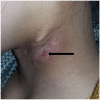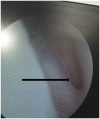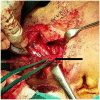Collaural fistula (Work Type II first branchial cleft anomaly) with prolonged morbidity: A case report
- PMID: 34035917
- PMCID: PMC8127753
- DOI: 10.1177/2050313X211014515
Collaural fistula (Work Type II first branchial cleft anomaly) with prolonged morbidity: A case report
Abstract
Collaural fistula is a very rare Work Type II first branchial cleft anomaly in which there is a complete fistulous tract between external auditory canal and the neck. Misdiagnosis and mismanagement can lead to prolonged morbidity and complications due to repeated infections. We present a case of an 18-year-old lady with a recurrent discharging sinus on her neck for 4 years. She has been treated with repeated incision and drainage and multiple antibiotics in the past. Otoscopic examination revealed an opening on the floor of the left external auditory canal. A diagnosis of an infected collaural fistula was made. Complete excision of the fistulous tract was done after treatment of the active infection. On follow-up, there was no further recurrence at 1 year. Sound knowledge of embryology of branchial anomalies with good history and examination is important to make correct and early diagnosis to prevent morbidity.
Keywords: Branchial anomaly; branchial cleft; collaural fistula; neck abscess; otolaryngology.
© The Author(s) 2021.
Conflict of interest statement
Declaration of conflicting interests: The author(s) declared no potential conflicts of interest with respect to the research, authorship and/or publication of this article.
Figures
Similar articles
-
A fatal case of severe neck abscess due to a third branchial cleft fistula: morphologic and immunohistochemical analyses.Diagn Pathol. 2016 Sep 15;11(1):87. doi: 10.1186/s13000-016-0540-0. Diagn Pathol. 2016. PMID: 27628180 Free PMC article.
-
Importance and Impact of Appropriate Radiology in the Management of Branchial Cleft Anomalies.Indian J Otolaryngol Head Neck Surg. 2019 Oct;71(Suppl 1):953-959. doi: 10.1007/s12070-019-01634-w. Epub 2019 Mar 23. Indian J Otolaryngol Head Neck Surg. 2019. PMID: 31742101 Free PMC article.
-
Collaural Sinus: A Case Report.Mymensingh Med J. 2021 Jan;30(1):233-237. Mymensingh Med J. 2021. PMID: 33397881
-
Clinical Manifestations, Diagnosis, and Management of First Branchial Cleft Fistula/Sinus: A Case Series and Literature Review.J Oral Maxillofac Surg. 2020 May;78(5):749-761. doi: 10.1016/j.joms.2019.12.017. Epub 2020 Jan 7. J Oral Maxillofac Surg. 2020. PMID: 32008991 Review.
-
Complete branchial fistula. Case report and review of the literature.Ann Otol Rhinol Laryngol. 2001 Nov;110(11):1077-9. doi: 10.1177/000348940111001116. Ann Otol Rhinol Laryngol. 2001. PMID: 11713922 Review.
References
-
- Bajaj Y, Ifeacho S, Tweedie D, et al.. Branchial anomalies in children. Int J Pediatr Otorhinolaryngol 2011; 75: 1020–1023. - PubMed
-
- Waldhausen JHT. Branchial cleft and arch anomalies in children. Semin Pediatr Surg 2006; 15: 64–69. - PubMed
-
- Souza ARD, Uppal HS, De R, et al.. Updating concepts of first branchial cleft defects: a literature review. Int J Pediatr Otorhinolaryngol 2002; 62: 103–109. - PubMed
-
- Ghosh S, Roychoudhury A, Prasad S. Collaural fistula: a diagnostic challenge. Int J Head Neck Surg 2017; 8(4): 153–156.
-
- Verma H, Dass A, Singhal S, et al.. Second type of first branchial cleft anomaly. Indian J Otol 2016; 22(4): 291–293.
Publication types
LinkOut - more resources
Full Text Sources
Other Literature Sources
Miscellaneous





